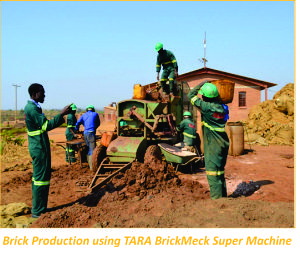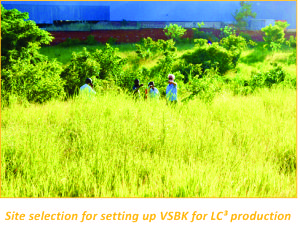|
Clean Building Technology Transfer to Malawi
The
Republic of Malawi is a land locked country situated in Southern Africa.
With a population of around 17.6 million, average growth rate of 2.9%
and an average annual per capita income of USD 402.4 , it is among the
poorest countries in the world. According to the projection made by a
population census (NSO 2008, pp. 26), the total rate of urbanisation in
the country is projected to reach 50% by 2050. This immense pace of
urban growth will put tremendous pressure on the country’s fledgling
building material sector.
Currently, brick production in Malawi is highly decentralised and unorganised. The entire Malawi brick industry uses open clamps for firing. There is no control over the firing process in the clamps. Lack of appropriate technology and know how in the Malawian brick manufacturing sector results in irregular bricks in terms of shape, size and quality. The sub-standard bricks can compromise the integrity of the structures depending upon the construction practices used. Primarily, the fuel used in firing bricks in Malawi is fuel wood. It is estimated that around 850,000 tonnes of fuel wood will be required annually to produce bricks for satisfying demands for housing, in the absence of cleaner alternatives. In an effort to address the challenges of improving the brick industry in Malawi, CCODE undertook a study on energy efficient and environmentally friendly methods of brick production. The study identified the Vertical Shaft Brick Kiln (VSBK), the most energy-efficient brick technology in the world, as a promising solution . Thus, CCODE after having carried out a feasibility study in 2012 and a baseline study in 2013 ventured towards creation of the enterprise Eco-Matters Ltd, which involved the construction of a VSBK pilot plant, colloquially called the EcoKiln. Meanwhile, CCODE with support from GIZ, TARA (the social enterprise wing of the Development Alternatives Group) and several other organisations has successfully piloted the VSBK technology in Malawi. In parallel, dissemination workshops have been carried out with the aim of creating more awareness among Malawian entrepreneurs. The initiatives are meant to promote a larger agenda of introduction of cleaner building material technologies in Malawi, going beyond the EcoKiln. The technology transfer process was anchored for the past couple of years through local Malawi institutions e.g. Eco-Matters Ltd., NCIC, TEVETA with support from Homeless International, UK and DFID (India), in addition to GIZ. Moreover, in order to build resilience of communities against flooding caused by cyclone Idai and to help in reducing the occurrences of flooding during such events, the project titled ‘More Income and Employment in Rural Areas of Malawi’ (MIERA), currently in phase III, proposes to expand the existing programme for the dissemination of environmentally friendly building material production technologies to the regions affected by Idai. Being good in quality and conforming to Malawi Bureau of Standards norms, these bricks made out of EcoKiln technology will improve the quality of houses and provide much-needed alternate livelihoods to Idai affected people.
Case Study: Vertical Shaft Brick Kiln for
LC3 Production in Malawi Lafarge Cement Malawi is a member of the Lafarge Holcim group established in 1968. Lafarge is currently operating a grinding unit in Blantyre and is the market leader in cement production and innovation. It produces four cement products namely: DuraCrete (CEMII 32.5N), Kumanga (MC 22.5X), Supaset (CEMII 42.5R) and Khoma (MC5). In the recent past, most of the clinker used by Lafarge was imported from other countries to Malawi. However due to rising transportation costs both by sea and land, import of clinker and grinding in Malawi is becoming less economically feasible. Moreover, due to relaxation in import license of cement by the Malawian Government, international cement players like Dangote Cements are exporting cheap cement from Zambia. Thus the Malawian cement companies do not have any choice but to look at alternatives of reducing production costs, improving quality and diversifying into speciality products. Limestone Calcined Clay or LC3 can be a good choice for Lafarge Cement Malawi. LC3 is a family of composite cement containing clinker, calcined clay and limestone. The LC3 technology promises a sustainable growth of economies around the world by reducing CO2 emissions by more than 30% compared to plain portland cement at lower production costs. As LC3 cement uses raw materials and technologies that are already commonly used in cements and can be used in the same way as normal cements, LC3 provides a practically viable solution to improve sustainability. Due to the lower clinker content, LC3 technology has several advantages over Ordinary Portland Cement (OPC) and fly ash based Portland Pozzolanic Cement (PPC). The main advantages will be:
LC3 allows a clinker substitution of around 50-60%, by a synergetic combination of calcined clay and limestone. For LC3 production, raw clay is usually calcined by rotary kiln which is continuous in nature and used for large scale production. Specially for small scale of calcination (<50 tonnes /day), Vertical Shaft Brick Kiln or VSBK is a better option. VSBK has several advantages over rotary kiln as illustrated below:
Considering the potential advantages of VSBK as mentioned above, Lafarge Malawi opted for VSBK technology for calcination of clay in LC3 application. There is a huge reserve of clay near Lafarge plant at Blantyre. Successful lab and pilot trials were conducted in Malawi under the guidance of TARA, the social enterprise wing of the Development Alternatives Group. Lafarge clay was calcined in VSBK. Standard LC3 batch was produced using the calcined clay and tested. The new blended cement with 50% reduced clinker was equivalent to CEMII 42.5R grade. The results were very promising and reproducible. Consequently, Lafarge Malawi decided to use VSBK for calcination of clay during commercial production of LC3 in Malawi which is undoubtedly an eco-efficient approach. ■ Endnotes:
Biswajit Swain, Palas Kumar
Halda
|

